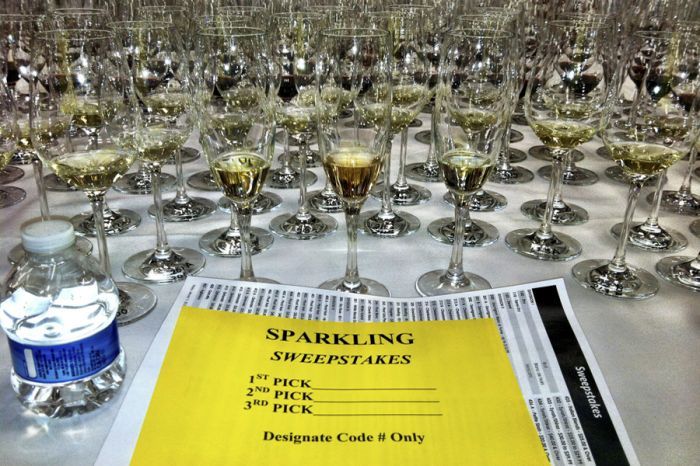Judiciously Judged

By Karl Klooster
We hear repeatedly how wine is subjective. It really doesn't matter whether someone else likes or doesn't like a wine you enjoy or don't like. Drink what you prefer, and forget about what other people think.
However, it’s only human nature to heed the advice of experts. When you hear a certain wine has just won a big tasting competition, it makes an impression.
Among top-tier wine tasting competitions, none is more highly regarded than the San Francisco Chronicle’s annual contest. Since it began in 1983, the event has grown to be the largest of its kind in the world. It started out with just wines from California’s North Coast counties — Napa, Sonoma, Mendocino, Lake — then Northern California was added, followed by all of California, and then Oregon, Washington and Idaho. In 2006, the welcome mat for eligible entries was extended to wines from anywhere in the country.
This year, approximately 5,500 entries were submitted from 25 states, giving the more than 60 judges plenty to swirl, sniff, sip, savor, spit and sometimes even swallow the entries over a four-day period, Jan. 8–11.
Winning wines must truly stand out in an event of such scope and scale. This year, 10 Oregon wines came away with top honors.
Two earned Best of Class status: Schmidt Family Vineyards 2009 Southern Oregon Tempranillo, $36; and South Stage Cellars 2008 Rogue Valley Syrah, $26.
Double-golds were awarded to Brandborg Vineyard 2011 Umpqua Valley Gewürztraminer, $18; and Del Rio 2011 Rogue Valley Viognier, $20.
Golds were presented to Abacela 2011 Umpqua Valley Albariño, $18; Spangler 2009 Southern Oregon Claret, $25; Schmidt Family Vineyards 2011 Southern Oregon Pinot Gris, $22; Willamette Valley Vineyards 2011 Pinot Gris, $16; and Willamette Valley Vineyards 2011 Riesling, $14.
If you wondered how the Pinot Noirs ranked, the old saying "You have to enter to win," applies. Oregon Pinot producers, understandably, decline being subjected to the California palate, which primarily rewards jammy, tannic and extracted interpretations over complex and nuanced ones.
Much closer to home, the 2013 McMinnville Wine & Food Classic wine judging was conducted Jan. 26 at St. James School. A total of 190 wines from 51 wineries went into the glasses of 12 judges during the course of the daylong session.
Only Oregon wineries could enter, but a few sourced wines from Washington grapes and one from California were in the mix. The outcome saw a Best of Show awarded along with 10 gold medals.
Best of Show was awarded to Methven Family Vineyards 2011 Willamette Valley Gamay Noir, with Abacela 2011 Umpqua Valley Albariño a close second but still winning gold — not incidentally, the Albariño took gold in the San Francisco Chronicle competition.
Other gold winners included: Abbey Creek Vineyard 2010 Pinot Noir, Eola Hills Wine Cellars 2010 LaCreole Pinot Noir, Terra Vina 2010 Cabernet Franc, Eola Hills Cellars 2010 Old Vine Zinfandel, Terra Vina 2009 Tempranillo, Capitello 2010 Dolcino and Noble Estate 2011 Semi-sparkling Muscat.
Points may have placed these wines into the medal round, but lively discussion of their merits took them to the top with a group of expert evaluators, including winemakers, retailers, restaurateurs, wine writers and wine buffs.
Speaking of big winners in Oregon, one of the biggest would be Argyle Winery's Extended Tirage Vintage Brut. In that regard, I must extend my apologies to the folks at Argyle.
Not too long ago, I failed to give full credit to the magnetism of this extravagantly expressive sparkling wine. It can be said without exaggeration that Arygle’s Extended Tirage ranks right up there with the greatest French Champagnes.
I reported that it was among Wine Spectator's Top 100 of 2012, and had won that honor once before. Argyle's Hospitality Supervisor Tim Thielen corrected my error.
"The Argyle Extended Tirage has a history of being in the Top 100 four times," Thielen noted. "The 1997 vintage, the 1998 and the 1999. Three-years-in-a-row streak! Now, with the 2002, that makes four times."
Though it's not an inexpensive wine — $70 a bottle — simply compare it against the latest Tête de Cuvée releases of Champagne's most heralded houses: Dom Perignon, $160; Louis Roederer Cristal, $190; Bollinger RD, $140; Perrier Jouet Fleur de Champagne, $120; Veuve Clicquot La Grande Dame, $120; and Laurent Perrier Grand Siecle, $130.
This isn't meant to be a pitch for Argyle, but it is an excellent example of how Oregon wines can equal if not surpass their European counterparts in quality at a fraction of the price. You don't need to conduct a blind tasting to determine the benefit of that fact.









